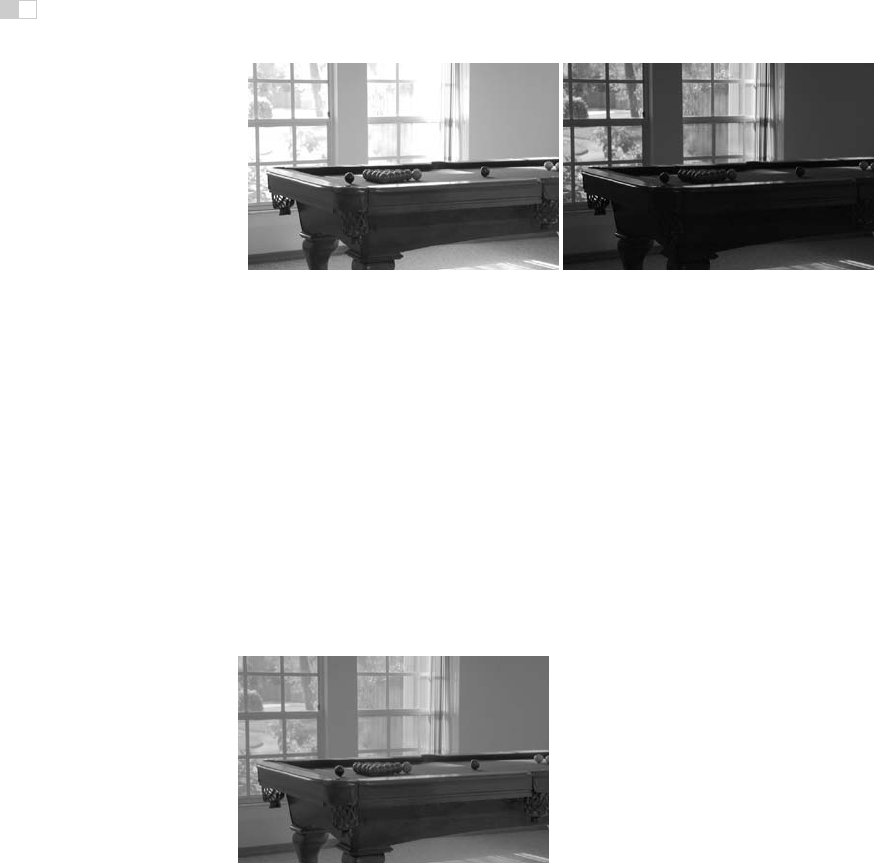
i
i
i
i
i
i
i
i
2 3
2 3
Erik Reinhard
Tone Reproduction
As discussed in Chapter 22, the human visual system adapts to a wide range of
viewing conditions. Under normal viewing, we may discern a range of around 4
to 5 log units of illumination, i.e., the ratio between brightest and darkest areas
where we can see detail may be as large as 100, 000 : 1. Through adaptation
processes, we may adapt to an even larger range of illumination. We call images
that are matched to the capabilities of the human visual system high dynamic
range.
Visual simulations routinely produce images with a high dynamic range
(Ward Larson & Shakespeare, 1998). Recent developments in image-capturing
techniques allow multiple exposures to be aligned and recombined into a single
high dynamic range image (Debevec & Malik, 1997). Multiple exposure tech-
niques are also available for video. In addition, we expect future hardware to be
able to photograph or film high dynamic range scenes directly. In general, we
may think of each pixel as a triplet of three floating point numbers.
As it is becoming easier to create high dynamic range imagery, the need to
display such data is rapidly increasing. Unfortunately, most current display de-
vices, monitors and printers, are only capable of displaying around 2 log units
of dynamic range. We consider such devices to be of low dynamic range. Most
images in existence today are represented with a byte-per-pixel-per-color chan-
nel, which is matched to current display devices, rather than to the scenes they
represent.
Typically, low dynamic range images are not able to represent scenes with-
out loss of information. A common example is an indoor room with an out-
597

i
i
i
i
i
i
i
i
598 23. Tone Reproduction
Figure 23.1. With conventional photography, some parts of the scene may be under- or
over-exposed. To visualize the snooker table, the view through the window is burned out in
the left image. On the other hand, the snooker table will be too dark if the outdoor part of this
scene is properly exposed. Compare with Figure 23.2, which shows a high dynamic range
image prepared for display using a tone reproduction algorithm.
door area visible through the window. Humans are easily able to see details of
both the indoor part and the outside part. A conventional photograph typically
does not capture this full range of information—the photographer has to choose
whether the indoor or the outdoor part of the scene is properly exposed (see Fig-
ure 23.1). These decisions may be avoided by using high dynamic range imaging
and preparing these images for display using techniques described in this chapter
(see Figure 23.2).
There are two strategies available to display high dynamicrange images. First,
Figure 23.2. A high dynamic range im-
age tonemapped for display using a recent
tone reproduction operator (Reinhard & De-
vlin, 2005). In this image, both the indoor
part and the view through the window are
properly exposed.
we may develop display devices which
can directly accommodate a high dy-
namic range (Seetzen et al., 2003,
2004). Second, we may prepare high
dynamic range images for display on
low dynamic range display devices (Up-
still, 1985). This is currently the more
common approach and the topic of this
chapter. Although we foresee that high
dynamic range display devices will be-
come widely used in the (near) future,
the need to compress the dynamic range
of an image may diminish, but will not
disappear. In particular, printed media
such as this book are by their very na-
ture low dynamic range.
Compressing the range of values of an image for the purpose of display on
a low dynamic range display device is called tonemapping or tone reproduction.
Get Fundamentals of Computer Graphics, 3rd Edition now with the O’Reilly learning platform.
O’Reilly members experience books, live events, courses curated by job role, and more from O’Reilly and nearly 200 top publishers.

